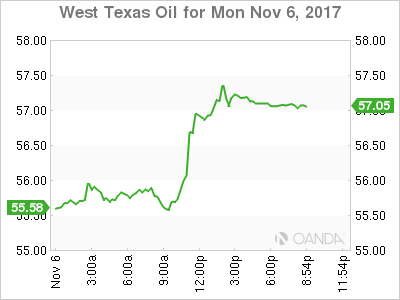The Canadian dollar appreciated 0.29 percent on Monday. Trading opened for the USD/CAD at 1.2771 and is now on track to end near the 1.2721 price level. The economic calendar looks sparse this week, but geopolitical developments around the world are driving market movements. Oil prices have surged due to the high profile arrests in Saudi Arabia that have consolidated the power of crown prince Mohammed bin Salman.
Canadian purchasing managers remain optimistic about the economy. The Ivey PMI survey beat expectations with a 63.8 reading reaching a 21 month high. The Canadian economy had a strong first half that defied expectations that prompted the Bank of Canada (BoC) to lift the benchmark interest rate twice by 25 basis points. The slowdown in the second half has been forecasted, but as the Canadian jobs number last week and today’s PMI shows there are still positive signs in Canada.

The USD/CAD lost 0.29 percent on Monday. The currency pair is trading at 1.2721 after the US dollar struggled on Monday after concerns about the tax reform rose. The US dollar did not get a strong boost form the employment numbers released on Friday. The greenback fell when the U.S. non farm payrolls (NFP) report showed the US economy added 261,000 jobs, 50,000 short of the forecast. Despite the upward 18,000 revision to the September figures the biggest miss was the hourly wages remaining flat. The U.S. Federal Reserve is expected to raise interest rates in December, but lack of inflationary pressure will make further tightening more complicated.
The Canadian economy added 35,300 jobs with the gains coming in full time employment. Forecasters had predicted a 15,000 gain. Wages also rose to the biggest gain in 18 months boosting the loonie agains the dollar for a 0.38 percent gain on Friday. The improvement in economic data once again has put forth the argument for another rate hike before the end of the year. The BoC already hiked twice in 2017, but only by enough to return to 2015 levels. The Canadian benchmark rate stands at 1 percent.
Marketpulse analyst Kenny Fisher wrote about the nomination of Jerome Powell to the position of Chair of the U.S. Federal Reserve:
On Thursday, US President Trump nominated Federal Reserve Governor Jerome Powell to head the Federal Reserve. Powell will take over in February 2018 when Yellen’s term expires. Powell is expected to hold the course with monetary policy, which has been marked by incremental and small rate hikes since December 2015. It’s all but a given that the Fed will raise interest rates in December, but the forecast for 2018 is less clear. If the US economy continues to grow at current levels, we could see up to three rate hikes next year. Powell will also be tasked with continuing to trim the Fed’s huge balance sheet of $4.2 billion. Last month, the Fed has started trimming the balance sheet by $10 billion/mth, but these cuts are expected to increase in size next year.
US President Donald Trump deliver his nomination before embarking on an Asian trip. The Trump administration is hard at work pushing the tax reform into fruition but it faces the usual obstacles that have plagued other policy initiatives as there are plenty of divisive points that could urge caution from even Republican senators ahead of next year’s primaries.

The price of energy is surging on Monday. West Texas Intermediate is trading at 57.23 after rising 3 percent. The crackdown in Saudi Arabia which resulted in high profile arrests raised concerns about the stability of the kingdom. Saudi Arabia’s crown prince Mohammed bin Salman has risen as the next in line to succeed his father. He has been the main driver of reform to diversify away from oil revenues and this move could end up silencing the most powerful critics of his plans.
Prince Mohammed bin Salman was the main force behind the economic boycott against Qatar in June and a showdown with Iran seems to be a question of when, not if it will happen. The Organization of the Petroleum Exporting Countries (OPEC) decision to cut production alongside Russia and other energy supplying nations has provided stability to the energy market.
Disruptions have been the main factor lifting prices above current ranges, but this last move by Saudi Arabia could unravel the OPEC as it pits major members against each other.
Weekly inventory releases will get further scrutiny, but will not have their normal effect in current rarified market conditions. The Energy Information Administration (EIA) will release oil stocks on Wednesday, November 8 at 10:30 am EDT.
Market events to watch this week:
Tuesday, November 7
1:45 pm CAD BOC Gov Poloz Speaks
Wednesday, November 8
11:30 am USD Crude Oil Inventories
4:00 pm NZD Official Cash Rate
4:00 pm NZD RBNZ Rate Statement
5:00 pm NZD RBNZ Press Conference
Thursday, November 9
9:30 am USD Unemployment Claims
8:30 pm AUD RBA Monetary Policy Statement
Friday, November 10
5:30am GBP Manufacturing Production m/m












